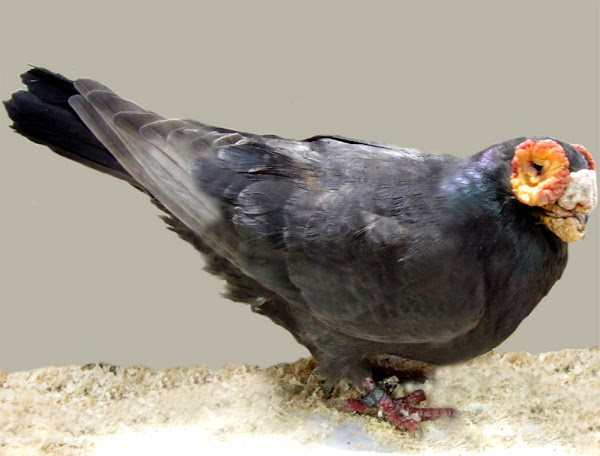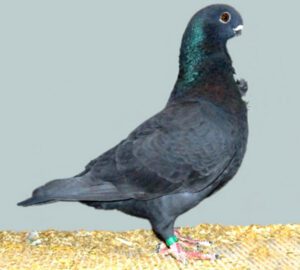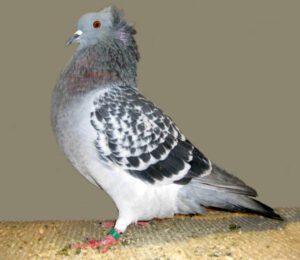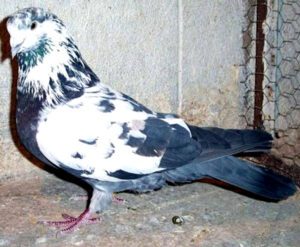The Barb pigeon is a breed of domestic fancy pigeon from United Kingdom. It is also called the English Barb and Barbary Pigeon. And the breed was developed in England over many years of selective breeding. This breed and other varieties of domesticated pigeons, all are descendants from the wild or feral rock pigeon.
It is a pretty old breed and has been around for a white, dating as far back as the 1600s. Although full history of this breed has been lost over the years.
But most people believe that the breed was originally imported into Europe from Barbary in North Africa. Most notable fact about the Barb pigeon is the wattling around the eyes and beak. And this wattling can take up to two years to fully develop into the fleshy flower-like ring around the eyes.
The Barb pigeon was referred to by Shakespeare. And it was also referred to with an illustration in Charles Darwin’s Variation of Animals and Plants under Domestication. However, read some more information about this beautiful pigeon breed below.
Origin And History Of Barb Pigeon
The origin of the Barb pigeon can be traced back to North Africa, where it was developed by the Berber people through selective breeding. The bird’s distinctive appearance and exceptional flying ability made it a popular breed among pigeon fanciers and enthusiasts in Europe, and it was later introduced to the United States, where it remains a sought-after breed to this day.
Characteristics
Barb pigeon is a small to medium sized bird with short face. It is stocky and a wattled pigeon breed. It stands out because of the large, knobby, red circles of bare flesh around the eyes, in addition to the knobby, wrinkled cere over the bill. Average body height of these birds is around 13.4 inches. And their average live mature body weight is around 370 grams.

Behavior
The Barb pigeon is known for its friendly and social personality. It is a highly intelligent bird that thrives on social interaction, making it a popular choice for those who want a pet that is easy to train and enjoys spending time with humans. In addition to being social, the Barb pigeon is also a highly skilled flier. It is able to fly at high speeds and for long distances, making it a popular choice for pigeon racing competitions. The bird’s exceptional flying ability is due in part to its broad wings and powerful muscles, as well as its natural instinct to navigate and orient itself based on its surroundings.
Housing
Proper housing is essential for the health and well-being of Barb pigeons. The housing should be spacious, well-ventilated, and secure, with perches and nesting boxes that meet the birds’ needs. Regular cleaning and maintenance of the housing is also important for preventing the spread of disease and maintaining the health of the birds. By following these tips, you can create a comfortable and safe environment for your Barb pigeons.
Feeding
Feeding Barb pigeons a balanced and nutritious diet is essential for their health and well-being. A diet that includes a variety of carbohydrates, proteins, and fats, as well as vitamins and minerals, will help to keep the birds healthy and strong. Feeding on a regular schedule, providing access to clean water, and limiting treats to healthy options are also important factors in maintaining a healthy diet for Barb pigeons.
Breeding
Breeding Barb pigeons is very easy and simple. Select a healthy breeding pair, provide a comfortable nesting environment, and ensure that the birds receive a balanced and nutritious diet.
Caring
Caring for Barb pigeons requires a commitment to providing a safe and healthy environment for the birds. By providing proper care you can ensure that your Barb pigeons thrive and enjoy a happy and healthy life.
Uses
Barb pigeons have several uses, including racing, shows, messenger services, companionship, and scientific research.
Special Notes
The Barb pigeon can be an excellent breed of domestic pigeon for you if you are looking for something with a little different appearance. This bird may look as if it has obstructed vision at first glance. But it can see and also fly well. Along with raising for exhibition purpose, the breed is also pretty good for raising as pets. Average lifespan of these birds is about 7-10 years. However, review full breed profile of this breed in the following chart.
| Breed Name | Barb |
| Other Name | Also known as English Barb and Barbary Pigeon |
| Breed Purpose | Exhibition |
| Special Notes | Beautiful birds, attractive uncommon appearance, very good for exhibition purpose, relatively calm, 7-10 years average lifespan |
| Breed Class | Small to medium |
| Weight | Around 370 grams |
| Climate Tolerance | Native climates |
| Flying Ability | Good |
| As Pets | Good |
| Color | Many |
| Rarity | Common |
| Country/Place of Origin | United Kingdom |






